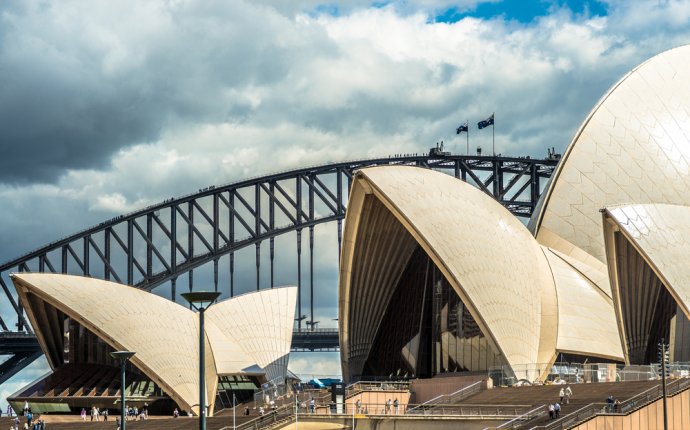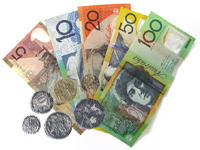
Best Place to exchange Money in Australia
The Australian currency is the Australian Dollar ($1 = 100 cents). The Reserve Bank of Australia controls the issue bank notes and coins. Australian Dollars are printed in Melbourne at Note Printing Australia and the Royal Australian Mint produces the coins of the currency. The Reserve Bank notes and the Mint's coins are legal tender in all Australian states and territories, and should be accepted wherever cash payment is accepted.
Each bank note and coin denomination has a distinctive size, shape and design.
Bank notes
Bank notes are issued in five denominations: $5, $10, $20, $50 and $100. It is common to find notes of any denomination being used in daily transactions, even the $100 note, but its use is less common and smaller stores might refuse to accept such a high denomination for small purchases. Each denomination is a different principal colour and each has special security features to limit counterfeiting.

| Note | Colour |
| $5
|
Pink/Mauve |
| $10 | Blue |
| $20 | Red |
| $50 | Yellow |
| $100 | Green |
All notes are sized according to their denomination for the visually impaired. They are the same height but different lengths, in order of their value ($5 being the smallest, $100 the largest).
Because of the aim to be cutting edge, counterfeits are rare and there are easy ways of checking. All Australian bank notes have a clear plastic "window" in the bottom right-hand corner of the note, and the larger denominations ($20, $50 and $100) have the value embossed on to this. Every note also has a seven-pointed star which has only half the printing on each side - hold it up to the light to see that it is genuine. There are other security features, but these should be more than enough.
Coins
Coins for circulation are issued in six denominations: 5c, 10c, 20c, 50c, $1 and $2. All denominations are in regular use. Some vending machines, other coin-operated machines and some other places (such as some toll booths) no longer accept 5c pieces as a method of payment.
Like bank notes, coins differ in size, shape and design. All coins have an image of Australia's Queen Elizabeth II and the words 'ELIZABETH II AUSTRALIA [YEAR]' on the obverse side.
| Coin | Remarks |
| 5c | The smallest and thinnest of the coins. 'Silver' in appearance. Reverse features an image of an echidna.
|
| 10c | Larger and slightly thicker than the 5c piece. 'Silver' in appearance. Reverse features an image of a lyrebird. |
| 20c | Larger and slightly thicker than the 10c piece. 'Silver in appearance. The 'standard' reverse image is of a platypus, but a range of commemorative 20c coins have been minted, each with different reverse image. |
| 50c | The largest of the coins. The 50c piece is in the shape of a 12-sided polygon and 'silver' in appearance. The 'standard' reverse image is of the Commonwealth coat of arms, but, like the 20c piece, there is a range of commemorative designs that can be seen on 50c coins.
|
| $1 | The $1 is smaller than the 20c piece. 'Gold' in appearance. The 'standard' image is of a mob of kangaroos, but this image varies on commemorative issues.
|
| $2 | The $2 is smaller than the 10c piece. 'Gold' in appearance. Reverse features image of an Aboriginal man and the Southern Cross.
|
There are no colloquial names for different coins; people refer to 'pieces' - '5c piece ' etc.
CURRENCY EXCHANGEDue to the unfavourable rates, usually coupled with fees and/or commissions for exchanging money at currency counters, it is recommended that you withdraw money from ATM machines, as needed, preferably using a bank affiliated with your bank when possible. Exchange counters are everywhere, say in Sydney for example. The rates at the Sydney Airport are the most egregiously lopsided in their favour, but most "buy" notes for 3-6% less than market value and sell for 3-6% more than market value and then add a fee/commission of $2.50-10. If you use, say Westpac Bank, and are a Barclays customer, there are no fees and the exchange rate pretty closely tracks the market price. Same for Citi customers, who will find Citi ATMs easy to spot.
Two additional benefits: (1) you can carry around less money while travelling; and (2) you only "exchange" the money you need and are not left holding a bunch of Aussie Dollars you cannot use, which you will most likely be selling back to a currency exchange at a discount on the last day of your trip.
Automatic Teller Machines (ATMs)The simplest way to obtain cash in Australia is to use an ATM. ATMs generally dispense only a mix of $20 and $50 notes and you can only withdraw a combination of these amounts, although some smaller ATMs, particularly in service (petrol/gas) stations dispense $10 notes but again only in combinations of $20 and $50, and some rare locations, particularly casinos, dispense $100 notes as well.
Thus, you can withdraw $20, $40 (2 x $20), $50, $60 (3 x $20), $70 (1 x $20 and 1x $50), $80 (4x $20) and every multiple of $10 past that.
ATMs are VERY reliable at dispensing their notes, but always check that you have taken them all. Some older ATMs dispense the notes in two lots, $20 and the $50, so always make sure you've got the right amount!
Location
ATMs are numerous in both city and country areas. ATMs in the walls of buildings on streets and inside the lobbies of banks, shopping centres and other buildings are numerous. At night, service stations and convenience stores are good places to look for ATMs away from the street. Pubs, especially in city areas, will usually have an ATM located on the premises. Some ATMs may require you to swipe your card to gain entry to a secure area.
Banks are normally only open weekdays 9.30-4pm Monday - Friday, some stay open until 5pm on Fridays. Bank staff stick to these times rigorously, so don't be late/early
Cards accepted
ATMs in Australia will usually allow withdrawal using any Australian-issued bank card. For international visitors, most ATMs allow withdraw using a card issued from a member of one of the international card networks (such as Cirrus or Maestro). A sign next to the ATM sill usually indicate what cards are accepted. Some ATMs (usually non-bank ones) do not allow withdrawal from credit cards.









